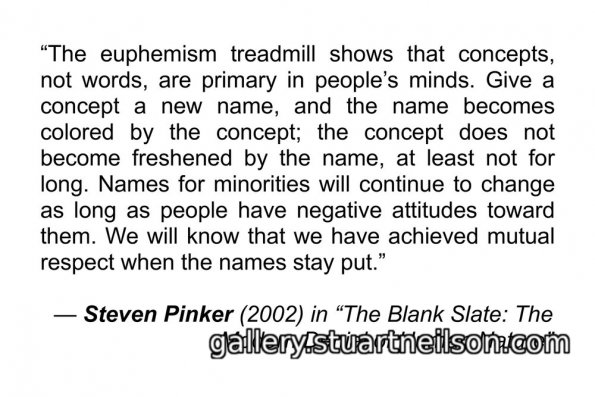Creating Autism – a four-part posting
1 History – 2 Geography – 3 Perspective – 4 Conclusions

Language is a complex network of interconnected words, like grooves guiding sentences. Deeply-etched language grooves are easy to say or write, reinforcing common perceptions and misconceptions.
Labels help to identify common themes, interests and categories of people, guiding us to appropriate responses and to like-minded communities. But we should always see the person before the label.
Different word choices can centre or remove the person in a narrative – ‘autism’ is a noun and a subject in its own right, whereas ‘autistic’ is an adjective demanding a noun – a child, son, partner or other human subject.
_595_stuartneilson.jpg)
Language is full of familiar patterns that are much easier to write or to say because they are widely used, often without much conscious thought about exact word choice. Familiar patterns of word use shape how we feel about a word – we talk about suffering from autism, or autism in a classroom. It is easy to forget to include the human subject in a conversation about autism traits, autism parenting or autism interventions.
Autism word network
The words (nodes) are sized in proportion to word frequency, selecting the most frequent words used in newspaper articles that include ‘autism’ and newspaper articles that include ‘autistic’. The words are connected by a line (directed edge) with a width proportional to the co-occurrence of the pair of words (in the direction of the arrow) – displaying phrases about autism, from left-to-right. The words and lines are coloured according to whether they occur more often with ‘autism’ or with ‘autistic’.
I use Graphviz to assemble word bigrams into networks representing frequent word usage and Bigram and Ngram analysis to generate word usage patterns. These widely published statistical techniques are fundamental to many modern internet processes using natural language as input, including internet (e.g. Google PageRank) search engines and automatic language translation.
_595_stuartneilson.jpg)


_595_stuartneilson.jpg)



Autism tends to be understood either as a medical disease or a social condition. The language used within, and the language appropriate to, these two groups is very different. Films and fiction (especially fiction written by people without direct experience of autism) often import inappropriate textbook terminology and diagnostic criteria directly into social situations, in search of accuracy or authenticity. There is no ‘correct’ language for all contexts, but using language with care is a choice to include autistic people in society, and a choice to respect individuality and autonomy.
_595_stuartneilson.jpg)
_595_stuartneilson.jpg)
_595_stuartneilson.jpg)
Autistic people inhabit a zone between medical and social understanding, simultaneously perceived by their medical needs and their social needs. Autistic people are rarely consulted about their own portrayal. Autistic interests, objectives and priorities rarely feature in public perception, and we rarely see the world as perceived by autistic people.
_595_stuartneilson.jpg)
, tiger-hunting (c 1592)_595_stuartneilson.jpg)





Consciously ‘changing groove’ has a dramatic impact on language, leaving behind many of the perceptions and mis-conceptions of one language pattern in favour of another. “Reclaiming the metaphor”, using existing familiar language in new ways, may be easier than creating unfamiliar new terms. Choosing respectful, empowering images that accurately reflect autistic people may ultimately liberate us from the ‘euphemism treadmill’.
Techniques and software
I am a statistician, mathematician and computer programmer, so I have used the tools I know to make the images I want to share. All the techniques I have used are published methods and all the software is Free and Open Source Software (meaning you can download and run the same code, with a little technical expertise).
These computer tools give me a sense of objectivity, because I feel that I am using a machine that repeatably generates the same output over and over, whoever was operating it. I am aware that my sense of objectivity is false, and these images are subjective and personal – just as the word ‘autism’ conveys a sense of scientific objectivity, disguising the equally subjective, diverse reality of autistic experience.